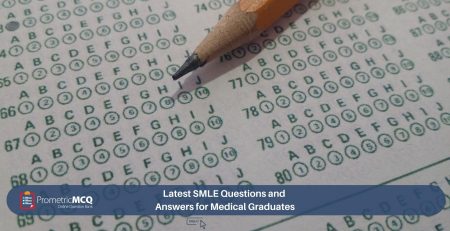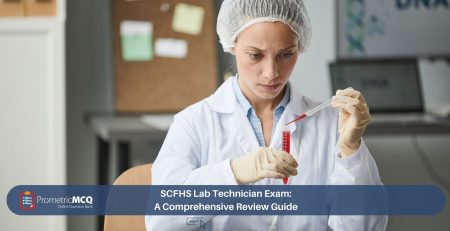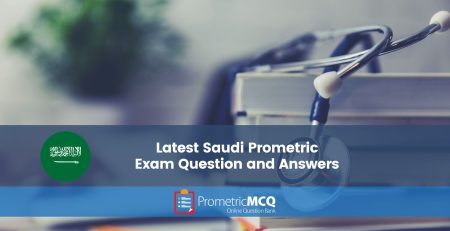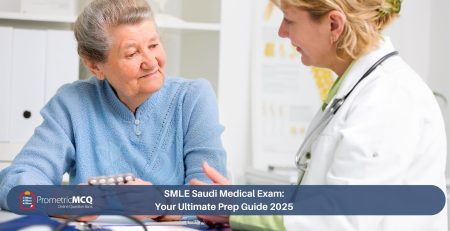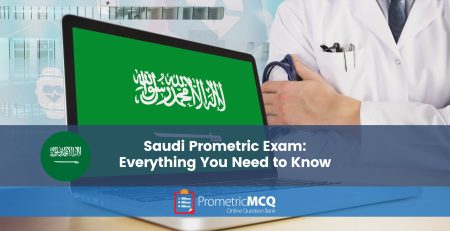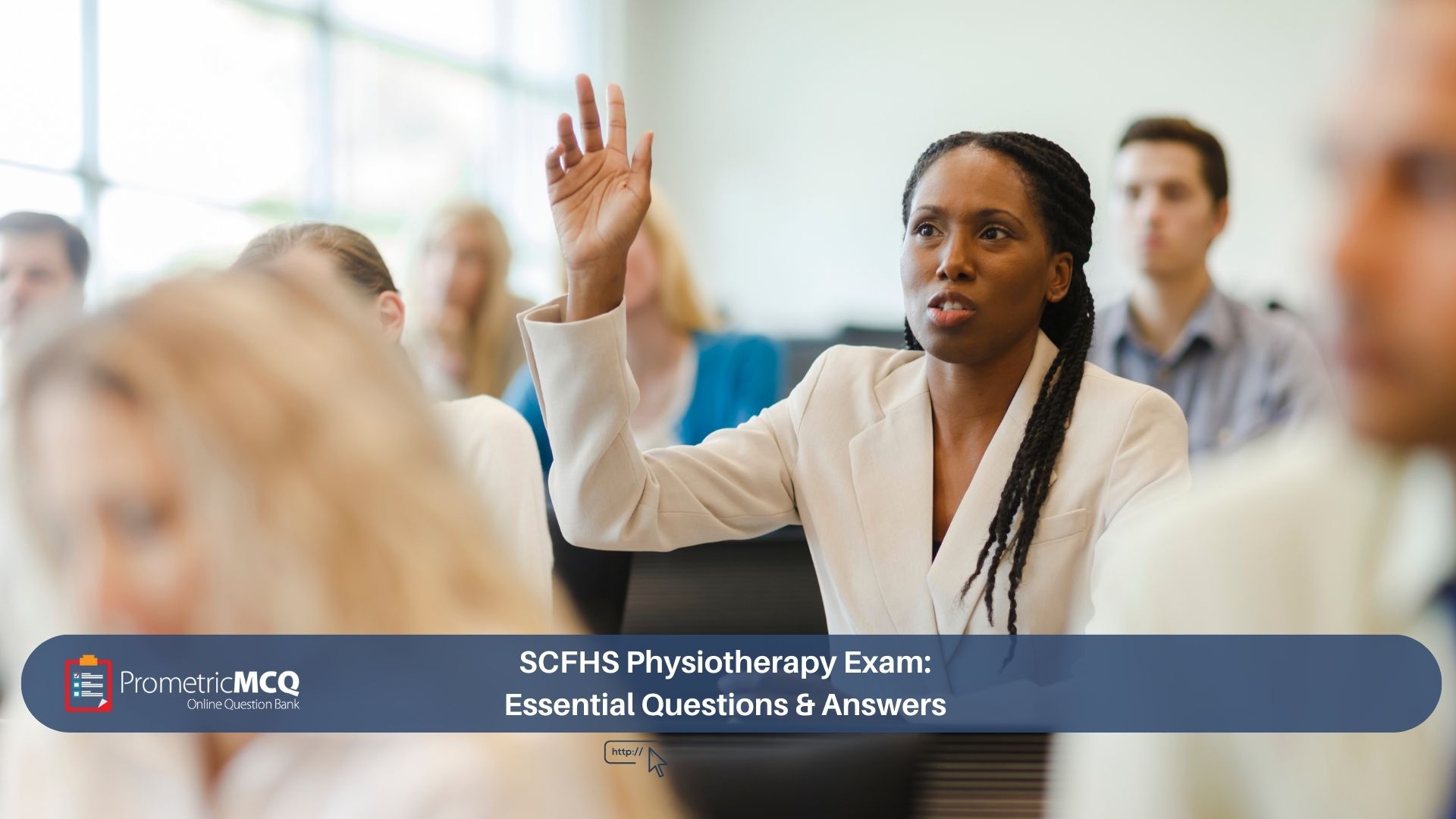
SCFHS Physiotherapy Exam: Essential Questions & Answers
fatima@prometricmcq.com2025-09-17T20:48:20+00:00Table of Contents
ToggleSCFHS Physiotherapy Exam: Essential Questions & Answers (2025)
For physiotherapists worldwide, the Kingdom of Saudi Arabia represents a frontier of professional growth, offering opportunities in advanced clinical settings as part of its ambitious Vision 2030. The key to unlocking this career path is the Saudi Commission for Health Specialties (SCFHS) Physiotherapy Prometric Exam. This is not just a formality; it is a high-stakes assessment designed to certify that your clinical skills, knowledge, and reasoning meet the Kingdom’s rigorous standards of patient care.
The secret to conquering this exam lies not in memorizing textbooks, but in mastering the application of knowledge through practice. The SCFHS exam is fundamentally a test of your clinical decision-making, presented in the form of Multiple-Choice Questions (MCQs). Each question is a clinical puzzle that requires you to assess a scenario, identify impairments, and select the safest and most effective intervention. Therefore, the most powerful preparation tool in your arsenal is a collection of high-quality, exam-style questions with detailed, explanatory answers.
This ultimate 2025 guide has been created to provide you with exactly that. We will dive deep into the essential questions you are likely to face, providing comprehensive rationales that illuminate the clinical reasoning behind each answer. This guide will serve as a complete roadmap, covering the exam’s structure, high-yield topics, a strategic study plan, and a detailed 10-point FAQ section to demystify the entire process from registration to success.
Key Takeaways for Exam Mastery
- Think Like a Clinician, Not a Student: Every question is a case study. Focus on assessment, differential diagnosis, and evidence-based interventions.
- Master Musculoskeletal Assessment: This is the largest part of the exam. You must have an expert-level recall of special tests, joint mobilization grades, and post-operative protocols.
- Prioritize Patient Safety: Be vigilant for red flags. Questions will test your ability to recognize when a patient needs urgent medical referral versus physiotherapy treatment.
- Know Your Modalities Inside and Out: Understand the indications, contraindications, and correct parameters for all common electrotherapy and thermal modalities.
- MCQ Banks are Your Best Friend: Consistent practice with a high-quality QBank is the single most effective way to prepare. For a targeted approach, explore our SCFHS Physiotherapy Exam MCQs.
Deconstructing the SCFHS Physiotherapy Exam Blueprint
A focused preparation strategy starts with a clear understanding of the exam’s content. The SCFHS exam for Physiotherapists (or Physical Therapists) is a computer-based test (CBT) with 150 MCQs to be answered in 3 hours (180 minutes). The blueprint is designed to reflect the core competencies of a general physiotherapist.
| Core Physiotherapy Domain | High-Yield Topics and Concepts for 2025 |
|---|---|
| Musculoskeletal Physiotherapy | The cornerstone of the exam. Covers the spine (stenosis, HNP), shoulder (impingement, rotator cuff tear, instability), hip (OA, FAI), knee (ACL, PCL, meniscal tears), and ankle (sprains, instability). In-depth knowledge of orthopedic special tests, manual therapy grades, and post-surgical rehab (TKR, THR, ACL-R) is essential. |
| Neurological Physiotherapy | A significant section focusing on Stroke (CVA), Spinal Cord Injury (SCI), Traumatic Brain Injury (TBI), Multiple Sclerosis, and Parkinson’s Disease. Key concepts include neuroplasticity, management of spasticity, balance retraining, and familiarity with scales like the Modified Ashworth, Berg Balance Scale, and ASIA impairment scale. |
| Cardiopulmonary Physiotherapy | Covers cardiac rehabilitation phases post-MI and CABG, management of chronic conditions like COPD, Asthma, and Bronchiectasis. Essential knowledge includes airway clearance techniques, interpretation of vitals during exercise, and understanding MET levels and the Borg scale. |
| General & Specialized Physiotherapy | This broad domain includes electrotherapy modalities (TENS, IFT, Ultrasound), pediatrics (Cerebral Palsy, developmental milestones), geriatrics (fall prevention), ergonomics, gait analysis, and professional ethics. |
Essential SCFHS Physiotherapy MCQs with In-Depth Answers
The following questions are designed to reflect the style and difficulty of the real exam. Use them not just to test your knowledge, but to practice the process of clinical reasoning.
MCQ 1: Musculoskeletal (Spine)
A 55-year-old male patient reports low back pain that radiates bilaterally down his legs. He states the pain is worse when walking downhill and standing for long periods, but is relieved by sitting or leaning forward on a shopping cart. Which of the following conditions is most consistent with this presentation?
- Lumbar Disc Herniation with Radiculopathy
- Lumbar Spinal Stenosis
- Ankylosing Spondylitis
- Sacroiliac Joint Dysfunction
ol>
Correct Answer: B
Rationale: This is a classic presentation of neurogenic claudication caused by lumbar spinal stenosis. The key symptoms are bilateral leg pain provoked by extension-based activities (walking, standing) and relieved by flexion-based postures (sitting, leaning forward). Leaning on a shopping cart flexes the lumbar spine, which temporarily increases the space in the spinal canal and relieves pressure on the nerves.
Why other options are incorrect:
A: Pain from a lumbar disc herniation is typically unilateral and is worsened by flexion activities (like sitting) and improved by extension.
C: Ankylosing spondylitis typically presents in younger males with morning stiffness that improves with activity, not worsens.
D: Sacroiliac joint dysfunction usually presents with unilateral pain localized over the SI joint, which can radiate but does not typically follow this extension-based pattern of relief/provocation.
MCQ 2: Neurological (Spinal Cord Injury)
A patient with a complete T4 spinal cord injury is exercising in the physiotherapy gym and suddenly complains of a pounding headache. The therapist notes that the patient is sweating profusely and their face is flushed. The initial blood pressure reading is 180/100 mmHg. What is the therapist’s most important immediate action?
- Lay the patient flat immediately to lower their blood pressure.
- Administer a prescribed sublingual nitroglycerin tablet.
- Sit the patient upright and check for noxious stimuli below the level of injury.
- Call for a medical emergency team and continue with gentle range of motion exercises.
Correct Answer: C
Rationale: These are classic signs and symptoms of autonomic dysreflexia, a medical emergency in patients with SCI at T6 or above. It is caused by a noxious stimulus below the level of injury (e.g., a full bladder, kinked catheter, tight clothing). The most important immediate action is to sit the patient upright to help lower blood pressure via orthostatic hypotension, and then immediately search for and remove the offending stimulus. Laying the patient flat would dangerously increase their blood pressure further.
Frequently Asked Questions (FAQs) for the SCFHS Physio Exam
The passing score for SCFHS Prometric exams is 500 out of a scaled score of 800, which is roughly 62.5%. To ensure a comfortable pass, your goal during preparation should be to consistently score above 70-75% on high-quality mock exams and question banks.
The process begins on the SCFHS’s online portal, Mumaris Plus. You will create an account, upload your educational and professional documents for classification, and then proceed with the Primary Source Verification (PSV) through the DataFlow Group. Once these steps are cleared, you will be issued an eligibility number to book your exam date with Prometric. A good starting point is our guide on Saudi Prometric exam registration.
A very high emphasis. You must know the names, procedures, and implications of the most common special tests for the shoulder (e.g., Neer’s, Hawkins-Kennedy, Drop Arm), knee (e.g., Lachman’s, Pivot Shift, McMurray’s), hip, and spine. Questions will often describe the result of a test and ask for your interpretation.
Yes. The SCFHS values evidence-based practice. You may be asked questions about the hierarchy of evidence (e.g., recognizing that a systematic review is stronger than a case study) or basic research terminology. The exam ensures that practitioners align with global standards, such as those promoted by World Physiotherapy, which champions evidence-based care.
Passing the exam makes you eligible for professional registration. After passing, you must ensure your DataFlow (PSV) report is complete and linked to your Mumaris Plus account. Once all requirements are met, you can complete the registration process on Mumaris Plus to be issued your official SCFHS license.
Create a summary chart. For each modality (Ultrasound, TENS, IFT, Shockwave, etc.), list its primary physiological effects, indications, contraindications, precautions, and standard parameters for common conditions. Questions on contraindications are particularly common as they relate to patient safety.
Yes, you absolutely need to know the normal range of motion values for all major joints (shoulder, elbow, wrist, hip, knee, ankle). Questions may provide a patient’s measured ROM and ask you to identify the limitation or its functional implication.
Candidates are generally allowed three attempts to pass the SCFHS Prometric exam. If a candidate fails three times, they may be required to undergo a period of re-training or an internship as determined by the SCFHS before they can be granted eligibility for a fourth attempt.
For pediatrics, expect questions on developmental milestones and the management of common conditions like Cerebral Palsy and Torticollis. For geriatrics, the focus is often on fall risk assessment (e.g., using the Berg Balance Scale or Timed Up and Go test) and rehabilitation for conditions like osteoarthritis and post-fracture recovery.
The quality of your practice questions is paramount. It is crucial to use a QBank that is specifically designed for the SCFHS Physiotherapy exam, featuring case-based scenarios and detailed rationales that explain both the correct and incorrect options. A comprehensive and specialized resource can be found at SCFHS Physiotherapy Exam MCQs.
Conclusion: Your Gateway to a Career in the Kingdom
The SCFHS Physiotherapy exam is a rigorous and comprehensive test, but it is a hurdle that can be cleared with confidence through strategic and dedicated preparation. Your success hinges on your ability to apply your knowledge in a clinical context. By focusing your energy on high-yield topics, engaging in thousands of practice MCQs, and meticulously analyzing the rationales, you are not just studying for an exam—you are honing the skills of a top-tier clinician. This diligent approach will pave your way to a successful career, contributing to the health and well-being of the community in Saudi Arabia.
Ready to Put Your Knowledge to the Test?
Our premium SCFHS Physiotherapy QBank is your ultimate study partner, offering thousands of high-yield MCQs, detailed expert rationales, and mock exams that simulate the real test environment to guarantee your success.


